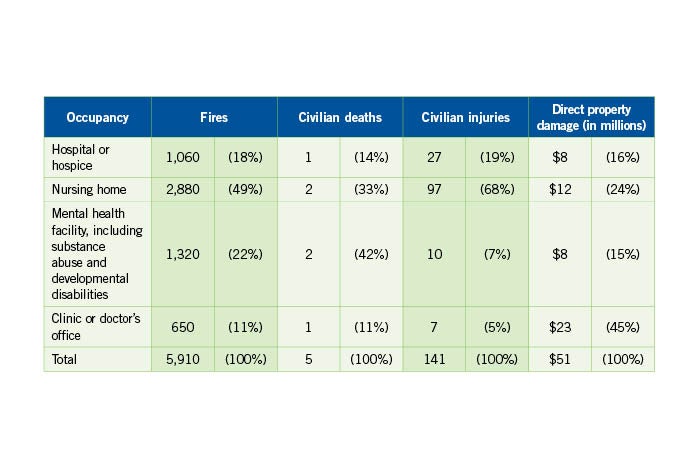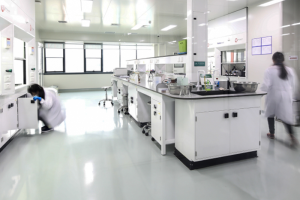Safely managing oxygen systems

Oxygen systems in hospitals require a robust operation management program.
Image courtesy of ASHE
In October 2020, over 150 patients were evacuated from a facility being utilized as a temporary hospital in Chelyabinsk, Russia. A few weeks later, two separate blazes took the lives of 10 patients in Romania and another 10 patients in Turkey. Then, in April 2021, 82 occupants at a Baghdad hospital perished in a catastrophic inferno.
All of these tragedies shared two commonalities: The fires were caused or suspected of being caused by issues related to oxygen-rich environments, oxygen storage or oxygen ventilation devices, and each disaster occurred during the COVID-19 pandemic — an event that, in most of these examples, exacerbated the fire risks.
“There have actually been dozens of fires in hospitals treating COVID-19 patients around the world since the pandemic began in the spring of last year, and nearly 200 people have died in those blazes,” says Angelo Verzoni, associate editor of NFPA Journal, the membership publication of the Quincy, Mass.-based National Fire Protection Association (NFPA). “For the most part, those incidents have occurred in countries where code compliance is often lacking, and they provide a sobering reminder of the critical importance of implementing and adhering to codes and standards in the health care setting.”
Risks always there
While none of these recent fires have occurred at U.S. hospitals, they have demonstrated that, when it comes to protecting against fires, vigilance is paramount to ensure patient safety, says Jonathan C. Willard, PMP, CHC, AP, MBE, owner of Acute Medical Gas Services Inc. in Goffstown, N.H.
“It’s critical to approach health care management with continuous improvement at the heart of our policies and procedures,” says Willard, who is a principal member of the technical committee on medical gas and vacuum piping systems, which is responsible for the applicable sections of NFPA 99, Health Care Facilities Code; and a principal member of the technical committee on industrial and medical gases, which is responsible for the NFPA 55, Compressed Gases and Cryogenic Fluids Code. “Managing oxygen systems in hospitals requires a robust operation management program to make sure they remain safe and reliable continuously.”
Fortunately, codes and standards like NFPA 99 and NFPA 101®, Life Safety Code®, provide comprehensive guidance on managing this hazard in American health care facilities.
“Stringent regulations, as well as oversight from the Centers for Medicare & Medicaid Services and other organizations, have helped U.S. hospitals remain safe,” says Chad Beebe, AIA, CHFM, CFPS, CBO, FASHE, deputy executive director for the American Society for Health Care Engineering (ASHE) in Chicago. “The rules, guidelines and codes we follow have been developed and further improved based on incidents like these fires in other countries. Our industry looks to see if there are any vulnerabilities in our regulations, and we usually respond quickly to those by adding new codes or providing clarity to existing codes.”
Nevertheless, facilities managers, engineers and the organizations they work for shouldn’t take anything for granted.
“Our country has an excellent track record of preventing deaths in fires in health care facilities due to a robust, multilayered system of code enforcement,” Verzoni says. “But it wasn’t always that way. Some of the world’s deadliest hospital fires occurred in the U.S. in the past century, including the Cleveland Clinic fire of 1929 that killed 120 people and the St. Anthony’s Hospital fire that claimed 74 lives in Illinois in 1949. We’ve come a long way in eliminating deaths by enforcing compliance with our codes.”
In fact, per NFPA data, fewer than one death occurred, on average, each year in fires in United States hospitals from 2014 to 2018 (see table on this page). Still, the physical environment in hospitals is forever evolving, with patient care spaces constantly being changed, moved, added or removed.
“Even though hospitals in the U.S. have enjoyed excellent fire safety over the past several decades, the risks are always there,” says Jonathan Hart, PE, SASHE, CHC, the NFPA’s technical lead and principal engineer.
Pandemic increases peril
Although oxygen itself is not a flammable gas, it’s an oxidizer, which means it can cause a fire to spread more easily and faster. And the significant increase in oxygen usage to treat coronavirus patients raises the odds of combustion, according to Jonathan Flannery, MHSA, FASHE, FACHE, ASHE’s senior associate director of advocacy. “There is no consensus on what oxygen percentage fosters an oxygen-enriched atmosphere,” Flannery says. “However, when the oxygen concentration in the air rises merely 3% higher than the naturally occurring 21% concentration, it’s sufficient to intensify the hazard of materials becoming easier to ignite and to burn more vigorously.”

Annual average estimates of structure fires in health care facilities between 2014 and 2018 as derived from fires reported to local fire departments through the U.S. Fire Administration’s National Fire Incident Reporting System and the NFPA Fire Experience Survey.
Fires by occupancy or property type, accessed from National Fire Protection Association data on May 25, 2021. Sums may not equal totals due to rounding errors. Fires that were not reported to the fire department are not included.
Willard explains that there are two types of oxygen systems employed in the health care setting that need to be fully understood. “The first is a centralized source of supply, which in most medium and large hospitals is a cryogenic liquid oxygen system, usually located outside of the hospital in an insulated storage vessel. These systems are connected to pipeline distribution systems that deliver the oxygen to the various locations of the hospital where it is needed for proper patient care,” Willard says. “They operate at very low pressures — 50-55 pounds per square inch gauge (psig), are monitored to ensure proper operation and are generally accepted as needing to be available at all times without fail because patients may be relying on them for survival.”
The second oxygen source allows for portability but introduces additional risk.
“Cylinders and containers store oxygen at very high pressures, up to 4,500 psig. If they are not stored or handled properly, they can be extremely dangerous,” Willard says. “An added fire concern arises when adiabatic heating occurs — the rapid pressurization of a system. When an oxygen cylinder is connected to a medical device, the device is usually not pressurized. After connecting the cylinder, the cylinder valve is opened to equalize the pressures. If this pressurization occurs too quickly, the temperature of the gas molecules rises; at a point of compression in the system, this heat could be sufficient enough to ignite a material it comes in contact with.”
With the increased need for respiratory therapy in the current pandemic, many systems have resorted to elevating the pressures in the systems to ensure adequate flow for the treatment areas.
“This can lead to failures in sensors, gaskets and joints,” says Mark Chrisman, Ph.D., PE, health care practice director and principal for Henderson Engineers, a national building systems design firm based in the Kansas City, Mo., area. “Furthermore, facility staff can be increasingly busy attending to the immediate needs of the facility and hospital staff, so there isn’t any bandwidth to attend to and monitor these systems. These factors aggregate to an elevated risk of oxygen-fueled fires.”
In addition to oxygen, the pandemic has forced health care facilities around the globe to store and use other potential fire hazards like hand sanitizer. “Complicating these issues is the fact that this storage and use sometimes occurs in spaces that were repurposed for patient care or created from scratch to deal with the surge in COVID-19 patients,” Verzoni says.
One area of the hospital that will remain on high alert for fire hazards — even as COVID-19 subsides — is the operating suite.
“The three elements a fire needs to ignite — heat, fuel and an oxidizing agent — are present in virtually all surgical procedures. Oxidizers, oxygen or nitrous oxide, heat sources, lasers or cauterizers, and fuel such as drapes or towels provide these elements,” Flannery says. “Optimal outcomes depend on all operating room (OR) staff being familiar with their roles in fire prevention and management and assuring that staff have the proper training, supplies and equipment.”
Fires in ORs sometimes happen around patients’ head and neck areas, where oxidizing gases like oxygen and nitrous oxide are routinely administered.
Collaboration and engagement
Recent hospital fire catastrophes outside the U.S. are a reminder of the importance of collaboration and engagement from the entire hospital team when evaluating risks during the pandemic and thereafter.
“Doctors, nurses, respiratory therapists and infection control professionals; maintenance, construction and safety personnel; and architects, engineers and vendors/manufacturers need to work together,” says Chrisman, who recommends collective efforts like performing risk assessments, drills and exercises, implementing and following procedures and best practices, and emphasizing proper fire safety training.
Recently, after performing increased ventilator load assessments at hospitals, Chrisman and his team identified several outlets with flow meters that were not completely shut throughout these facilities. “Not only is this oversight a wasteful and unnecessary draw on the system, but it elevates oxygen levels within the localized space, which can increase the risk of fire,” he says.
Also, many of the utility systems in older hospitals “are just not up to the current design standards for these systems. Even if maintenance has been routinely performed on them, they could still pose a fire hazard,” Willard says. “And some old systems and equipment might be leaky, adding oxygen to the environment even when not in use.”
For instance, ventilators and other respiratory devices, needed during the coronavirus crisis to administer oxygen to patients, are prone to leak without proper inspection, testing and maintenance. “Booms in ORs that have flexible hoses with threaded connections that are not easily accessible can also leak and create a hazard,” Willard says. “Oxygen can build up in housings where the flex connectors are installed, creating very high concentrations of oxygen in the small enclosures.”
Outdated code adoptions
Beebe says it’s unfortunate that the Centers for Medicare & Medicaid Services (CMS) continues to require the implementation of an older edition (2012) of NFPA 99 by U.S. hospitals that participate in Medicare and Medicaid. “Until CMS updates and begins utilizing newer editions of the code, we are not afforded any of the latest protections,” he says. “CMS needs to speed this up and adopt newer code standards. The NFPA updates its codes every three years; CMS is more than a decade behind the curve now.”
Flannery reiterates that sentiment. “The adoption of the NFPA’s most recent codes and standards by CMS would provide greater safety to patients in U.S. hospitals,” he says.
Consider that some requirements in the 2012 edition are in direct conflict with the most recent edition. “The 2012 edition does not allow for patient transport equipment to be placed in front of medical gas emergency shutoff valves,” Willard says. “However, the 2021 edition does allow for it. This conundrum exists with many more of the requirements hospitals are expected to follow.”
Several U.S. governmental health care authorities, such as the Department of Veterans Affairs and the Indian Health Service, already have implemented the latest NFPA standards and codes, as these authorities are allowed to do. “Yet non-federal government health care facilities are required by CMS to use the 2012 editions of the Life Safety Code and Health Care Facilities Code,” Flannery says.
It took CMS more than 13 years to move from the 1999 edition of NFPA 101 to the 2012 editions of NFPA 101 and 99, which occurred in 2016. “The technology and design changes that occurred in those 13 years are fairly significant,” Chrisman says. “With the technological advancements, we are seeing an even greater change from 2016 to now and expect that to continue to increase.”
Proactive practices
Organizations seeking to improve fire prevention efforts and better safeguard patients, staff and visitors are recommended to adopt the following best practices:
- Review and follow relevant codes and standards like NFPA 99 and NFPA 53, Recommended Practice on Materials, Equipment, and Systems Used in Oxygen-Enriched Atmospheres. These provide guidance on the safe storage, handling and administration of medical gases like oxygen and nitrous oxide. “In particular, adhere to the requirements of Chapter 5 and Chapter 11 of NFPA 99,” Hart says.
- Develop policies and procedures around medical gases that are based on Chapter 5 and Chapter 11 of NFPA 99 and tailored for the actual use and needs of the facility. “Also, ensure that storage locations comply with the code based on the volume of gas being stored in that location,” Hart says.
- Implement operation and management programs that address all critical systems and activities. “Perform daily rounds, conduct inventories of critical components and systems, operate inspection and maintenance programs with frequencies based on manufacturer recommendations, conduct boom inspections and leak testing as required by NFPA 99, and develop a permit-to-work system for medical gas and vacuum systems,” Willard says.
- Perform risk assessments of medical gas storage locations for compliance.
- Ensure that staff are trained and educated on all related policies, procedures and emergency operations, and require and provide necessary continuing education and updates on any policy changes.
- Confirm that all oxygen delivery equipment is functioning properly to minimize oxygen leakage and reduce the chance of an oxygen-enriched atmosphere occurring. Also, increase ventilation or exhaust to any area of concern to prevent the creation of an oxygen-enriched atmosphere.
- Check that all electrical equipment is properly functioning to decrease the odds of fire or electrical shortages.
- Upgrade old and/or leaking equipment or systems.
- Review cylinder storage locations for compliance.
- Use piped medical gas systems instead of portable cylinders when possible.
- Thoroughly inspect the piping system. “This can help identify any possible leaks or failures in the system in areas that may not be visible,” Chrisman says.
Everyone’s responsibility
During emergencies like the COVID-19 pandemic, it’s important for health facilities managers to be flexible and responsive to the needs of patients while also ensuring that the physical environment is safe and healing.
“This is the essential function of health care facilities managers,” Flannery says. “It is times like these that they must be able to assess all risks and provide the appropriate level of safety that will help protect patients but also allow for needed care and services.”
Recommended safety resources
Sources for the accompanying article suggested several resources health care facilities professionals can use to properly size medical gas systems, store oxygen, address medical gas-related fire hazards and help prevent oxygen-related fires. They include:
- “Piped Medical Gas Consumption Evaluation Tool” by the American Society for Health Care Engineering, which helps hospitals and health systems evaluate piped medical gas system capacity and show the usage of a particular medical gas system while different types of therapies are in use.
- “Medical Air and Oxygen Capacity” paper by Kaiser Permanente National Facilities Services, which provides ventilator capacity based on piping sizes to assist in determining how many ventilators can be served by an existing medical gas system in a given patient care area.
- “Sizing Medical Gases for Covid 19” paper by Beacon Medaes, which offers guidance on the sizing of medical gas systems for COVID-19 emergency units.
- “Handle and Connect Medical Gas Cylinders Safely” video by Beacon Medaes, which covers gas systems and operations.
- “Temporary Compliance Options for Code Modifications, Alternate Care Sites, and Facilities Related to Health Care” white paper by the National Fire Protection Association (NFPA), which covers provisional compliance options when it comes to medical gas, sprinkler systems, changes in physical spaces and more.
- “Considerations for Temporary Compliance Options in Health Care Environments During COVID-19” white paper by NFPA, which includes provisional compliance options meant to address challenges related to medical gas storage and other issues in health care facilities.
- “Safe Quantity of Open Medical Gas Storage in Healthcare Facility Smoke Compartments” report by NFPA, which addresses the hazards associated with medical gases.
- “Oxygen tank storage regulations” article by Health Facilities Management, which covers considerations to help ensure compliance with NFPA 99, Health Care Facilities Code.



